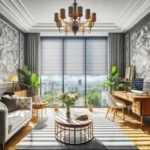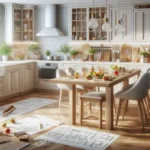Your home is a reflection of who you are, a canvas where your personality and tastes come to life through carefully selected décor and design.
Yet, with so many styles to choose from, finding the perfect aesthetic that resonates with you can be both exciting and overwhelming. From the cozy warmth of rustic charm to the sleek lines of modern minimalism, each home décor style tells a unique story and creates a distinct atmosphere. In this blog post, we invite you to embark on a journey of self-discovery as we explore the diverse range of home décor styles, including bohemian, industrial, farmhouse, and more. Whether you’re looking to revamp your space or simply seeking inspiration, this guide will help you uncover the aesthetic that best embodies your vision and transforms your home into a sanctuary that feels both stylish and uniquely you.
1. Introduction to Home Décor Aesthetics
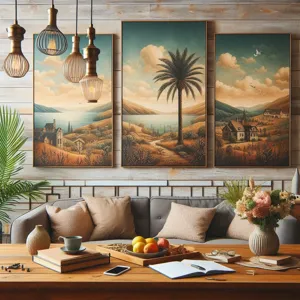
When it comes to creating a space that feels uniquely yours, understanding home décor aesthetics is essential. Your home is more than just a shelter; it’s a reflection of your personality, lifestyle, and values. The right aesthetic not only enhances the beauty of your surroundings but also contributes to a sense of comfort and belonging. With an array of styles to choose from, diving into the world of home décor aesthetics can be both exciting and overwhelming.
From the sleek lines of modern minimalism to the warm, inviting vibes of rustic farmhouse decor, each style tells a story and evokes a certain mood. Transitional designs blend elements from different genres, while bohemian spaces embrace eclectic patterns and vibrant colors, inviting creativity and individuality. Whether you’re drawn to the elegance of traditional interiors or the carefree charm of coastal themes, understanding these various aesthetics can help you curate a cohesive look that resonates with your personal taste.
In this exploration, we’ll demystify the most popular home décor styles, providing insights into their defining characteristics, color palettes, and key elements. Armed with this knowledge, you’ll be better equipped to discover your own aesthetic—transforming your home into a sanctuary that truly reflects who you are. So, let’s embark on this journey through the diverse realm of home décor styles and unlock the potential of your living space!
2. The Importance of Defining Your Aesthetic
Defining your aesthetic is more than just choosing a few colors or selecting trendy furniture pieces; it is about creating a cohesive environment that resonates with your personality and lifestyle. Your home is a reflection of who you are, and establishing a clear aesthetic can transform not only your space but also your overall well-being. When you define your aesthetic, you create a narrative that guides your decor choices, ensuring they harmonize with your vision.
Understanding your aesthetic helps streamline the decorating process, making it easier to select items that complement each other and fit your intended vibe. Whether you lean towards minimalist Scandinavian designs, cozy farmhouse charm, or bold bohemian flair, having a defined aesthetic acts as a roadmap. This clarity can save you from impulsive buys that might clash with your overall vision, preventing buyer’s remorse and unnecessary clutter.
Moreover, a well-defined aesthetic enhances the functionality of your space. It allows you to consider not just how your home looks, but how it feels and functions for you and your family. By evaluating your needs and preferences, you can create zones within your home that cater to different activities—like a serene reading nook, a vibrant entertainment area, or a calming workspace— all while ensuring they remain visually cohesive.
Additionally, the importance of defining your aesthetic extends beyond personal enjoyment. It can significantly affect the value of your home should you ever decide to sell. A well-curated space that reflects a distinct style can attract potential buyers, making it easier for them to envision living in your home. Ultimately, defining your aesthetic is about embracing and celebrating your individuality, allowing you to cultivate a living space that feels uniquely yours.
3. Overview of Popular Home Décor Styles
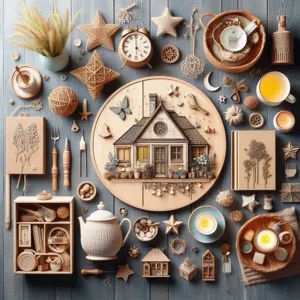
When it comes to decorating your home, understanding the various styles available can be both exciting and overwhelming. Each décor style carries its own unique charm, offering a distinct vibe that can transform your living space into a reflection of your personality and taste. Here’s an overview of some of the most popular home décor styles that you might consider as you embark on your aesthetic journey:
**1. Modern:** Characterized by clean lines, minimalist design, and a neutral color palette, modern decor embraces simplicity and functionality. Think open spaces filled with natural light, sleek furniture, and understated elegance. This style often incorporates innovative materials and blends seamlessly with contemporary art pieces.
**2. Bohemian:** For those who love eclectic and vibrant spaces, the bohemian style is a free-spirited approach to home décor. It celebrates individuality through an abundance of textures, layers, and colors. Rich patterns, vintage finds, and global influences come together to create a warm and inviting atmosphere, often adorned with plants and handcrafted items.
**3. Farmhouse:** Emphasizing comfort and coziness, farmhouse décor brings a touch of rustic charm into your home. Characterized by weathered wood, soft textiles, and vintage accents, this style evokes a sense of nostalgia. The color palette typically features whites, soft grays, and earthy tones, creating a serene and welcoming environment reminiscent of country living.
**4. Industrial:** Inspired by urban lofts and warehouses, industrial décor showcases raw materials such as exposed brick, metal, and concrete. This style is all about embracing the beauty of imperfection, with a focus on functional furniture and a muted color scheme. The industrial aesthetic often combines vintage elements with modern design, resulting in a unique and striking look.
**5. Scandinavian:** Known for its simplicity, functionality, and connection to nature, Scandinavian décor reflects a minimalist ethos. Light, airy spaces adorned with natural materials, soft color palettes, and cozy textiles create an inviting atmosphere. This style emphasizes decluttering and maximizing natural light, making your home feel both spacious and serene.
**6. Mid-Century Modern:** This timeless style, popularized in the mid-20th century, combines organic shapes with a playful use of color. Characterized by functional furniture, geometric patterns, and a seamless connection between indoor and outdoor spaces, mid-century modern design is both stylish and practical. The focus is on creating a harmonious balance of form and function.
By exploring these popular home décor styles, you can begin to identify which resonates with your personal aesthetic. Whether you prefer the sleek lines of modern design or the eclectic charm of bohemian flair, understanding these styles will help you curate a space that truly feels like home.
4. Modern Minimalism: Embracing Simplicity
Modern minimalism is more than just a design trend; it’s a lifestyle choice that emphasizes the beauty of simplicity and functionality. Rooted in the principle of “less is more,” this aesthetic embraces clean lines, uncluttered spaces, and a calming color palette, allowing each element to breathe and shine in its own right. When you step into a modern minimalist home, you are greeted by an atmosphere of tranquility, where every piece of furniture and decor serves a purpose and contributes to the overall harmony of the space.
The color scheme in a modern minimalist setting typically revolves around neutral tones—whites, grays, and beiges dominate, creating a serene backdrop that enhances natural light and promotes a sense of openness. Accents of bold colors may punctuate the decor, but they are carefully curated to maintain the overall sense of calm. Textures play a crucial role in modern minimalism, with organic materials like wood and stone offsetting the sleekness of metal and glass, adding warmth and depth without overwhelming the senses.
Furnishings in a modern minimalist home are often low-profile and functional, emphasizing geometric shapes and simplicity in design. Think of a low-slung sofa paired with a sleek coffee table, or a single statement chair that draws the eye without cluttering the room. Accessories are kept to a minimum, with a focus on quality over quantity. A few thoughtfully chosen art pieces or decorative objects can add personality while still aligning with the minimalist ethos.
Storage solutions are cleverly integrated to maintain the clean lines and open spaces characteristic of modern minimalism. Built-in shelves, hidden compartments, and multi-functional furniture help keep belongings out of sight, ensuring that surfaces remain clear and clutter-free. The result is a sanctuary that invites relaxation and mindfulness, where every moment spent in the space feels intentional and rejuvenating.
Embracing modern minimalism is about more than just aesthetics; it encourages a lifestyle that values simplicity and intentional living. By curating your home in this way, you not only create a beautiful environment but also cultivate a mindset that prioritizes clarity and peace, allowing you to focus on what truly matters in your life.
5. Bohemian Chic: Eclectic and Free-Spirited
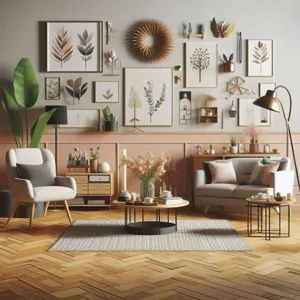
Bohemian Chic, often referred to simply as “Boho,” is a home décor style that embodies a vibrant and free-spirited lifestyle. This aesthetic draws inspiration from a myriad of cultures and eras, creating an eclectic mix that feels both lived-in and artistic. Imagine stepping into a space that feels like a vibrant tapestry woven from textiles and treasures collected from around the world—this is the essence of Bohemian Chic.
At the heart of this style is a celebration of individuality and self-expression. Bold patterns, vivid colors, and an assortment of textures come together to create a visually stimulating environment. Layering is key; think soft rugs piled on top of one another, an array of throw pillows in varying shapes and sizes, and wall hangings that might include everything from macramé to vintage tapestries. The use of natural materials such as wood, stone, and plants enhances the earthy vibe, making the space feel grounded and connected to nature.
Furniture in a Bohemian Chic home often consists of mismatched pieces that tell a story—perhaps a mid-century modern chair paired with a rustic antique table. Vintage finds and second-hand treasures play a significant role, giving the space a curated feel without being overly polished. This style encourages the use of handmade items, whether it’s artisanal pottery, handwoven baskets, or unique artwork, all contributing to a narrative that’s as much about the journey as it is about the destination.
Lighting also plays an essential role in establishing the Boho ambiance. Soft, diffused light from lanterns, fairy lights, or intricately designed lamps creates a warm and inviting atmosphere, perfect for late-night gatherings or quiet moments of reflection. Plants, both large and small, are often scattered throughout the space, adding life and a splash of color while promoting a sense of tranquility.
In essence, Bohemian Chic is more than just a décor style; it’s a lifestyle choice that invites you to embrace creativity, celebrate diversity, and cultivate a home that reflects who you are. Whether you incorporate just a few Boho elements or go all out with a full transformation, this aesthetic invites you to create a space that feels uniquely yours—eclectic, vibrant, and utterly free-spirited.
6. Rustic Farmhouse: Cozy and Inviting
The Rustic Farmhouse style embodies a warm, inviting atmosphere that harkens back to simpler times, making it a favorite among those seeking comfort and charm in their home décor. This style is characterized by a harmonious blend of natural materials, vintage accents, and a touch of practicality, resulting in spaces that feel both homey and stylish.
Imagine stepping into a rustic farmhouse kitchen, where weathered wooden beams stretch across the ceiling, and a large farmhouse table sits at the center, surrounded by mismatched chairs that tell stories of family gatherings and shared meals. The color palette typically features soft, muted tones—think creams, earthy browns, and sage greens—that evoke a sense of tranquility and connection to nature.
Key elements of this style often include reclaimed wood furniture, vintage metal accents, and woven textiles, all of which contribute to an overall sense of authenticity. Open shelving displays cherished dishware and mason jars filled with fresh herbs, while cozy throw blankets drape over the back of a well-loved sofa.
Decorative touches like galvanized metal buckets, mason jar centerpieces, and rustic lanterns complete the look, creating a space that is not only aesthetically pleasing but also functional. Whether it’s a charming living room with a stone fireplace or a sunlit porch adorned with potted plants, the Rustic Farmhouse style invites you to unwind and embrace the beauty of everyday life.
In a world that often feels fast-paced and overwhelming, this décor style serves as a gentle reminder to slow down, savor moments, and find joy in the simple pleasures of home. If you’re looking to create an environment that feels cozy and inviting, the Rustic Farmhouse aesthetic may just be your perfect match.
7. Industrial Style: Raw and Urban
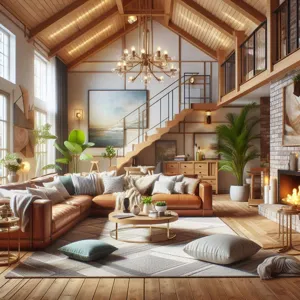
Industrial style is a captivating blend of raw materials and urban chic, creating spaces that are as functional as they are visually striking. Originating from the repurposing of old factories and warehouses, this design aesthetic embraces the beauty of imperfection and the allure of unfinished spaces. Picture exposed brick walls, weathered wooden beams, and polished concrete floors—all elements that evoke a sense of history and authenticity.
One of the most defining characteristics of industrial style is its commitment to showcasing the structural elements of a space. Open floor plans with high ceilings and large windows are hallmarks of this design, allowing natural light to flood in and highlighting the rugged textures that make industrial décor so appealing. You might also find exposed ductwork and piping, which not only serve a functional purpose but also add an edgy, architectural element to the overall look.
In terms of color palette, industrial style leans heavily on muted tones and earthy hues. Think deep grays, rusty browns, and blacks, often accented by pops of color through artwork or decorative accessories. Furniture pieces in industrial spaces tend to be minimalist and utilitarian, often crafted from reclaimed wood, metal, or leather. This emphasis on raw materials fosters a sense of durability and timelessness, ensuring that your décor stands the test of time.
To incorporate industrial style into your home, consider mixing modern furnishings with vintage finds. A sleek leather sofa paired with a reclaimed wood coffee table can create a perfect balance of comfort and rugged elegance. Accessories such as metal light fixtures, factory-style stools, and abstract art pieces can further enhance the industrial vibe, adding character and personality to your space.
Ultimately, industrial style is about embracing the beauty of rawness and celebrating the stories behind the materials used in your home. Whether you live in a loft, a renovated warehouse, or a cozy apartment, adopting this aesthetic invites an urban edge into your décor, transforming your space into a stylish and inviting sanctuary.
8. Scandinavian Design: Functional and Clean
Scandinavian design epitomizes the beauty of simplicity and functionality, making it a captivating choice for those looking to cultivate a serene home environment. Originating from the Nordic countries, this aesthetic is characterized by its minimalistic approach, emphasizing clean lines, natural materials, and a neutral color palette that brings a sense of calm and order to any space.
At its core, Scandinavian design prioritizes functionality without compromising on style. Furniture is often designed with practicality in mind, featuring multi-purpose pieces that maximize space—ideal for smaller homes or apartments. Think of sleek sofas that double as storage solutions or dining tables that can extend for gatherings. The emphasis is on creating an open, airy atmosphere that invites light and encourages a sense of coziness.
Natural materials play a pivotal role in this décor style. Woods, particularly light-toned varieties like oak and birch, are frequently used, lending warmth to interiors while maintaining a fresh, uncluttered feel. Textures are equally important; soft woolen throws, knitted cushions, and plush rugs add comfort and layers to a minimalist space, making it feel inviting rather than stark.
In terms of color, Scandinavian design often leans towards a muted palette—think whites, grays, and soft pastels—punctuated by occasional bold accents that can be introduced through artwork or decorative accessories. The goal is to create a soothing environment that promotes relaxation and mindfulness, reflecting the natural beauty of the surrounding landscapes.
Lighting is another critical element in Scandinavian homes, where long winter months demand well-thought-out illumination. Large windows allow as much natural light as possible, while strategically placed fixtures—often featuring sleek designs—enhance the overall aesthetic and create a warm ambiance.
Whether you’re drawn to the uncluttered nature of Scandinavian design or its harmonious blend of form and function, embracing this style can transform your living space into a serene retreat that feels both stylish and livable.
9. Traditional Elegance: Classic and Timeless
When it comes to home décor, few styles evoke the same sense of comfort and sophistication as Traditional Elegance. Rooted in history and characterized by classic design elements, this style reflects a deep appreciation for craftsmanship and a keen eye for detail. Traditional homes often feature rich wood finishes, ornate moldings, and elegant furnishings that tell a story of timeless beauty.
The color palette in a Traditional Elegance setting leans towards soft, warm tones, with colors such as cream, beige, deep burgundy, and forest green creating a welcoming atmosphere. Textures play a significant role, too; think plush fabrics like velvet and silk draping elegantly over antique furniture, paired with detailed patterns found in wallpapers and upholstery that echo the charm of eras gone by.
Incorporating traditional elements such as wingback chairs, tufted sofas, and intricately carved coffee tables can instantly elevate your space. Accessories like vintage mirrors, brass candlesticks, and fine china add layers of depth, while framed artwork and family portraits evoke a sense of nostalgia and personal history.
Lighting is crucial in achieving the Traditional Elegance aesthetic. Chandeliers, with their sparkling crystals, and table lamps with fabric shades provide warm, inviting light, enhancing the overall ambiance. Layering different light sources, from sconces to floor lamps, creates a cozy yet sophisticated environment.
Ultimately, Traditional Elegance is about creating a space that feels both refined and lived-in, a harmonious blend of formality and comfort that invites relaxation. By embracing this style, you not only honor the past but also create a timeless sanctuary that resonates with warmth and welcome for years to come.
10. Mid-Century Modern: Retro and Stylish
Mid-Century Modern design encapsulates an era of innovation and creativity that flourished between the 1940s and the 1960s. This aesthetic draws inspiration from the optimism of post-war America, blending form and function in a way that feels both retro and refreshingly contemporary. Characterized by its clean lines, organic curves, and a focus on simplicity, Mid-Century Modern emphasizes a seamless connection between indoor and outdoor spaces, often utilizing large windows and an open floor plan.
The color palette of Mid-Century Modern décor is as distinctive as its furniture—think rich earth tones, vibrant accents, and a harmonious mix of both. You’ll often find warm woods like walnut or teak paired with pops of color from bold fabrics or statement pieces in shades of mustard yellow, teal, and burnt orange. Iconic furniture pieces, such as the Eames lounge chair or the Noguchi coffee table, are hallmarks of this style, showcasing meticulous craftsmanship and innovative materials like molded fiberglass and metal.
In Mid-Century Modern homes, décor is kept minimal yet impactful. Accessories are carefully curated; think geometric patterns, sleek ceramics, and abstract art that reflect the era’s artistic movements. The aim is not to overwhelm, but rather to create an inviting space that encourages conversation and relaxation. By integrating plants and natural elements, this style fosters a sense of tranquility, making it perfect for those who seek a balance between sophistication and comfort.
Whether you’re a devoted fan of retro design or simply looking to add a touch of vintage charm to your home, Mid-Century Modern offers a timeless elegance that continues to inspire and captivate. Embrace this aesthetic by sourcing authentic pieces or modern interpretations, and watch as your space transforms into a stylish homage to a beloved design era.
11. Coastal and Nautical: Fresh and Breezy
Coastal and nautical décor styles evoke the soothing essence of the ocean, bringing a refreshing and breezy atmosphere into your home. This aesthetic is all about creating a serene retreat that mirrors the beauty of seaside living, regardless of how far you are from the actual shore. With its light color palettes, natural materials, and whimsical maritime accents, this style fosters a sense of calm and relaxation.
Imagine stepping into a space adorned with soft whites, sandy beiges, and gentle aquas that mimic the ebb and flow of the tide. Light, airy fabrics—like linen and cotton—are often used for window treatments and upholstery, allowing sunlight to filter through and illuminate the room. Textured elements like jute rugs and driftwood accents enhance the connection to nature, while nautical motifs, such as ropes, anchors, and seashells, lend a playful charm.
In a coastal-inspired home, furniture pieces are typically uncomplicated and functional, often featuring weathered finishes that mirror the look of sun-bleached wood. Open shelving displays a curated collection of beachcombed treasures and nautical knickknacks, inviting conversation and nostalgia. Whether it’s the subtle scent of sea salt wafting through the air or the sound of waves crashing in the distance, the coastal aesthetic invites you to unwind and bask in the tranquility of your surroundings.
To fully embrace this style, consider incorporating elements that reflect your personal connection to the sea, such as artwork depicting marine life, photographs of coastal landscapes, or even a gallery wall showcasing your favorite beach memories. By blending these elements with your unique flair, you can create a home that not only looks beautiful but also feels like a serene getaway, no matter where you are.
12. Eclectic Style: Mixing and Matching
Eclectic style is a vibrant celebration of individuality, where the ordinary rules of home décor are thrown out the window in favor of personal expression and creativity. This style thrives on the idea that there are no boundaries when it comes to choosing furnishings, colors, and art; it invites you to mix and match elements from various eras, cultures, and design philosophies to create a space that truly feels like you.
Imagine walking into a room where a vintage mid-century chair sits comfortably next to a modern glass coffee table, while a colorful, handwoven Persian rug anchors the space beneath. Walls adorned with an eclectic mix of artwork—from abstract pieces to family portraits—tell a story of your travels and personal experiences. Here, bold patterns and textures coexist harmoniously, as a geometric-print sofa pairs effortlessly with floral-patterned throw pillows, creating a delightful visual contrast.
At the heart of eclectic style is the art of layering. It encourages you to play with various materials and colors, allowing your creativity to shine. Don’t shy away from mixing wood, metal, and fabric; the beauty of eclectic décor lies in its ability to tell a unique story through unexpected combinations. Perhaps you’ll find a sleek, contemporary lamp illuminating a collection of rustic wooden sculptures, or a vibrant pop of color from an oversized piece of art that brings the room to life.
When embracing eclectic style, the key is to maintain a sense of balance. While variety is the spice of life in this décor approach, cohesion is vital to avoid a chaotic look. This can be achieved by selecting a unifying color palette or theme—perhaps focusing on warm tones or nature-inspired hues that can be found throughout the room. Additionally, consider incorporating a few statement pieces that act as focal points, drawing the eye and grounding the space amidst the diverse elements.
Ultimately, eclectic style is about embracing what you love, allowing your personality to shine through every aspect of your home. Whether you’re drawn to the bohemian charm of global finds or the sleek appeal of modern art, the eclectic approach invites you to create an inviting, dynamic environment that feels uniquely yours. So, let your imagination run wild, and remember: in the world of eclectic décor, the only rule is to have fun!
13. How to Choose the Right Décor Style for You
Choosing the right décor style for your home is a deeply personal journey that reflects not just your tastes but also your lifestyle and personality. Begin by evaluating your preferences—think about the colors that make you feel at peace, the textures you find comforting, and the overall atmosphere you wish to create. Do you gravitate towards the clean lines of modern minimalism, or are you enchanted by the cozy warmth of rustic farmhouse aesthetics?
Start with inspiration; browse through design magazines, websites like Pinterest, or home décor shows to gather ideas. Create a mood board that showcases elements that resonate with you—this could include furniture styles, color palettes, patterns, and even artwork. Pay close attention to the details that catch your eye, as these will guide you in forming a cohesive style.
Consider your lifestyle as well. If you have young children or pets, a more durable and practical style, such as industrial or bohemian, might be better suited to withstand wear and tear while still looking stylish. Conversely, if you prioritize relaxation, a soft, muted palette with plush furnishings might align perfectly with your vision of comfort.
Don’t forget to reflect on the architecture of your home; it can often provide hints about which décor styles will harmonize best. A Victorian house, for example, may call for a more traditional approach with rich fabrics and antique furnishings, while a sleek, contemporary home may shine with a minimalist or Scandinavian aesthetic.
Ultimately, selecting the right décor style is about creating a space that feels authentically you. Take your time, trust your instincts, and remember that your home is a living reflection of who you are—embrace the journey of discovery!
14. Tips for Incorporating Your Aesthetic into Your Home
Incorporating your aesthetic into your home is a rewarding journey that allows your personality to shine through in every room. Whether you lean toward bohemian charm, modern minimalism, rustic farmhouse, or eclectic vibrancy, there are practical steps to infuse your unique style into your living space.
**1. Start with a Color Palette:** Every aesthetic has its signature colors. Begin by selecting a palette that resonates with you. For a coastal vibe, think soft blues and sandy beiges; for a mid-century modern look, consider warm earth tones paired with pops of bright color. Paint your walls, choose furnishings, and accessorize with these hues in mind to create a cohesive look.
**2. Mix Textures and Materials:** Texture can elevate your décor style significantly. Pair smooth surfaces with rough ones; for instance, a sleek glass coffee table can be beautifully contrasted with a chunky knit throw or a reclaimed wood side table. The interplay of materials—like combining metal, wood, and fabric—can add depth and intrigue to your space.
**3. Curate Your Furniture:** Select furniture pieces that reflect your aesthetic and serve a purpose. For a vintage-inspired look, scour thrift stores for unique finds, while modern styles may benefit from streamlined, functional furniture. Remember, each piece should not only be visually appealing but also comfortable and practical for your lifestyle.
**4. Add Personal Touches:** Your home should tell your story. Incorporate personal mementos, such as artwork, photographs, or travel souvenirs, that resonate with your aesthetic. These items can evoke cherished memories and give your space a sense of warmth and individuality.
**5. Layer Lighting:** Lighting plays a crucial role in setting the mood of your home. Use a combination of ambient, task, and accent lighting to highlight different areas. Soft, warm light can enhance a cozy, rustic feel, while sleek, bright fixtures can underscore a modern aesthetic. Don’t forget to choose lamps and shades that complement your overall design theme.
**6. Embrace Greenery:** Plants can breathe life into your home, adding color and texture while improving air quality. Select houseplants that fit your aesthetic; succulents or cacti for a minimalist look, or lush ferns and flowering plants for a bohemian vibe. Use decorative pots that echo your color palette to tie everything together.
**7. Create Zones:** If you have an open-plan space, define different areas by using rugs, furniture arrangements, or decorative screens. This helps to create distinct zones that reflect various aspects of your aesthetic. For example, a reading nook can feature a comfy chair, a small bookshelf, and a stylish floor lamp, all harmonizing with your chosen style.
By thoughtfully incorporating these elements, you can create a home that not only looks stunning but also resonates with your personal aesthetic. Remember, the key is to stay true to yourself; your home should be a reflection of who you are, providing a sanctuary that feels uniquely yours.
15. Conclusion: Creating a Space that Reflects You
In conclusion, creating a space that reflects you is not just about choosing the right furniture or paint color; it’s about weaving together your personal story, experiences, and tastes into a cohesive aesthetic. As we’ve explored the diverse range of home décor styles—from the minimalistic charm of Scandinavian design to the vibrant energy of bohemian chic—you’ve likely discovered elements that resonate with your own preferences.
Remember, your home should be a sanctuary that nurtures your spirit and accommodates your lifestyle. It’s perfectly acceptable to blend styles, allowing your individuality to shine through while embracing the beauty of contrast. Whether you prefer the rustic warmth of farmhouse décor or the sleek lines of contemporary design, the key is to infuse your personality into every corner of your space.
As you embark on this creative journey, take the time to experiment and curate pieces that speak to you. Don’t shy away from mixing textures, colors, and patterns that evoke joy and comfort. Let your walls tell your story—through cherished photographs, unique art pieces, and treasured keepsakes that spark memories.
Ultimately, your home should be a reflection of who you are. It’s a canvas waiting for your touch, a space where you can relax, entertain, and thrive. So, take the plunge, embrace your unique aesthetic, and create a haven that not only looks beautiful but feels authentically you. Happy decorating!
As we wrap up our exploration of various home décor styles, we hope you’ve found inspiration and clarity in discovering your unique aesthetic. From the cozy charm of farmhouse decor to the sleek lines of modern minimalism, each style offers a distinct way to express your personality and create a space that truly feels like home. Remember, your home is a canvas waiting for your personal touch, so don’t hesitate to mix and match elements that resonate with you. Whether you choose to embrace bold colors, natural textures, or timeless elegance, the key is to create an environment that brings you joy and comfort. So go ahead, dive into the world of décor, and let your creativity flourish as you transform your living space into a reflection of your style. Happy decorating!


